|
|
||||
|
Complexity has a price, and a renewables grid is a bit like a 240 volt moving Rubiks cube. Here we see an unnecessary project hit by a random factor that in turn will affect all the others, blowing out other costs and schedules. Australia’s breakneck energy transition, driven like a crash test dummy by government subsidies, depends on finishing the massive pumped hydro scheme called Snowy 2.0. However it has hit another delay no one apparently saw coming. “Australia’s biggest renewable energy project” is the $6 – 10 billion plan to pump water uphill so it can run back down again to generate electricity every time the windmills and solar panels suffer a catastrophic failure, which is nearly every day. The entire project is superfluous in a grid with coal power — as we know from the last fifty years when we didn’t need it. Unfortunately a 2,400 ton Tunnel Boring Machine called Florence is quite stuck under a cave-in. According to the ABC she started ten months ago, and is supposed to be digging her way through 15 kilometres (10 miles) of mountain. The stuck bore can’t go forwards, but she can’t go back the way she came in either. The team has installed concrete reinforcing behind Florence as she moved and the concrete reinforcing effectively locks her in. It’s meant to be a one way trip. So we have the irony of a machine designed to carve through miles of rock trapped inside a pile of sand. But it gets worse. Last month, the Snowy Hydro Corporation said it was monitoring a “surface depression” above the boring machine. So a local man decided to go looking for the hole. As he says “technically, [Florence] should be 9 kilometers in but I thought I’d start about 3 kilometers out and start walking my way back in,” Mr Anderson said. He spent four days looking for the hole only to find it, wow, barely 150 meters from the entrance. His big shock was not the hole, but that the tunnel borer had barely achieved anything at all. These machines are designed to travel 30 to 50 meters a day, so this short tunnel is effectively one week’s work. The Snowy 2.0 scheme is supposed to be finished by December 2026, (just revised a week ago to Dec 2027) but at the current rate of 60 centimeters (2ft) a day it will take about 70 years to finish. Looks like we will need those old coal plants for a bit longer. This delay could affect the rollout of new renewables. Future options include jacking it up (described as “a huge task”) or disassembling Florence — all 143 meters and 2,400 tons — and extracting the machine in pieces. But if they do that, they will have to start the whole tunnel again. Still they hadn’t got very far… You’d never know Australia was a top mining nation, eh? Pumped Hydro is giant appliance that sucks electricity and gives you back some later. In a system with reliable baseload generators it is superfluous, redundant, and entirely unnecessary. It is an expense we don’t have to have, didn’t need, and don’t want to pay for. It can only make things more expensive than the system we used to have. Not only do we have to pay for the giant infrastructure, every day it operates we also throw away 20 – 30% of the electrons (so to speak) that go through it. Snowy 2.0, is twice the cost, half the value, wastes a quarter of the energy, and wrecks the environment tooThe mammoth pumped Hydro scheme is a $10 billion dollar disaster that will never pay for itself, is already being superseded by battery technology, and will scar the land, infect pristine alpine lakes, risk critically endangered species, damage fishing grounds, and breach the Biosecurity Act in a National park. (Where are the environmentalists, Tim Flannery? Does anyone care?) UPDATE: A net-zero grid (without nuclear power) needs 23 Snowy 2.0 schemes for storage: Australian Financial Review, April 2022 The Australian Energy Market Operator estimates that by 2050, without coal power plants, the National Electricity Market will require 45 GW and 620 gigawatt-hours of storage in all its forms to manage variations in fast-growing wind and solar generation, and to keep the grid stable. The figure rises steeply the closer the grid gets to 100 per cent renewables. Snowy chief commercial officer Gordon Wymer points to an old estimate from ITK Services that some 8000 GWh – 23 times the capacity of Snowy 2.0 – could be needed for a fully renewable NEM, while Snowy’s own estimates signal that three to five times the capacity of 2.0 is needed for a 50-60 per cent renewable grid. (ITK principal David Leitch says his estimate is out of date and refers back to AEMO’s estimates.) Snowy 2.0 needs huge transmission line construction as well (Humelink and VNI West): There’s another $6 billion in transmission lines that we didn’t need for a coal fired grid. Australian Financial Review, April 2022 “The cost/benefit analyses undertaken by TransGrid and also by AEMO makes quite clear that HumeLink plus Snowy 2.0 – they go together, the one is useless without the other – will destroy the wealth of New South Wales electricity consumers and Australian taxpayers,” says Bruce Mountain, director of longstanding Snowy 2.0 critic, Victoria Energy Policy Centre at Victoria University. He says findings by AEMO and TransGrid that HumeLink provides net benefits only get to that conclusion by ignoring the cost of Snowy 2.0. Broad argues the new transmission was required as long as 10 years ago, pointing to the bottlenecks in the system that prevent even the existing Snowy hydropower output reaching Melbourne and Sydney during demand spikes on hot summer days. Lack of grid capacity is also crimping new wind and solar generation, he notes, saying the critics are “missing the point” and getting caught up in “the politics of who’s doing what”. Broad fears the $3.3 billion HumeLink will slide into 2027, while the $3 billion VNI West, which three years ago was expected by 2028, is now pencilled in for July 2031 in AEMO’s latest draft grid blueprint but may slip into 2032.
h/t David B By Jo Nova It’s a song for the times by Hi-Rez – the rapper: 2+2=5 . There really are professors explaining that maths proficiency is white supremacy. Guest starring Robert Malone and JP Sears 2 + 2 = 5 LyricsKick the fathers out the house Keep reading →  Art by Ofjd125gk87 By Jo Nova In the next great environmental cult moment, “The Science” has a plan to explode a 10-billion-kilogram dust cloud off the moon between the Earth and the Sun. Shimmery white moon dust will dim the evil solar rays and “save us from our addiction to fossil fuels” (at least until we run out of Moon). The dust will disperse every couple of weeks, so we just need to keep topping up our global sunscreen by setting the explosives off. At least it probably won’t kill many whales. The plan involves getting man back on the moon for the first time in fifty years, setting up a moon base, and a permanent mining colony, but (guard your coffee) — it might be cost effective: Squirting a carefully calculated stream of Moondust from a future lunar station at the right point between the Sun and Earth might be the most cost-effective, risk-free means of keeping our cool until we come to our senses and cut emissions. But not as cost effective as spending 0.000000001% of that to check the science and blow up a few climate models instead. Because we all enjoyed the Little Ice Age, right?Bromley notes the proposal would mimic the scenario that occurred during the Little Ice Age, when Louis XIV reigned over France. You’d need a lot of dust but, provided you could get it into space, it would essentially work to reduce solar radiation, blocking around 1% to 2% of the light. What luck, God made the moon out of just the right cheese? “Lunar dust stood out for two reasons,” said Bromley “First, it can be pretty efficient at deflecting sunlight, and second, it turns out that the most efficient grain size is the most plentiful on the moon’s surface.” This, he notes, was a fun surprise and something they didn’t know going into the project. One of the problems, though, is just how much dust is required. It would be cost prohibitive to constantly send rockets full of space dust to a platform out at L1, so the moon provides a second advantage. Exploding bombs on the moon will either waste a continent worth of money or — if it works — make the Earth less habitable, reduce crops, increase frosts, and shrink coral reefs. But it will apparently “buy us time to mature as a society”. Put yourself in the naughty corner. People in 100 years are going to find this very funny. Why wait? Laugh now… Latest Mind-Blowing Suggestion For Cooling The Planet Involves Blasting The Moon
With each passing year, the effects of rising global temperatures become even more obvious, while the chances of avoiding greater catastrophes in the future retreat like every melting glacier. Desperate to avoid worst-case scenarios, researchers have proposed various measures that could, at the very least, buy us the time we might need to mature as a society and work to undo the damage. Blasting a steady stream of dust from the surface of the Moon is the latest suggestion to get a solid scientific appraisal, with University of Utah computational astrophysicist Ben Bromley and computer scientist Sameer Khan and Smithsonian Astrophysical Observatory astrophysicist Scott Kenyon giving the idea a tentative thumbs up. UPDATE: Think of what a nice bureaucratic model this is. NASA / ESA / NOAA gets more money to do what they want to do anyhow, and they can tweak the program to suit the weather. If the world cools they claim “success”. If the world doesn’t cool, they can point to how essential this program is to stop extreme heat. Give me your money… Whatever happens to the weather, the climate modelers will tell us how useful the moon dust was and another international bureaucracy is born. Science communicators have mastered the art of treating adults like 6 year olds. Logic? The logical thing to do would be to work together to kick our nasty habit of smoking fossil fuels. Shocking as it seems, it could be faster and easier to engage in mammoth-scaled engineering projects that literally reflect a proportion of sunlight before it hits Earth and is converted into a form that’s likely to stick around as heat. Keep reading → 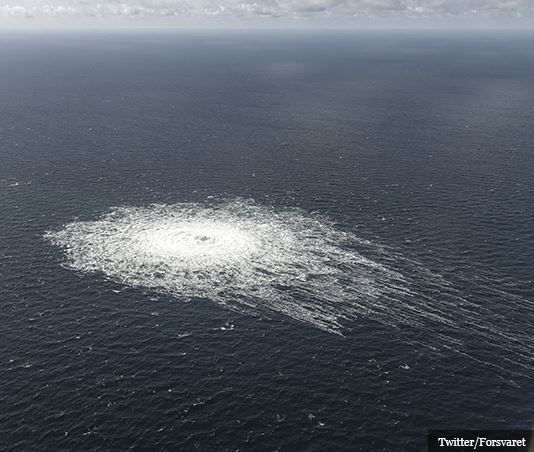 Nordstream explosion. Twitter Forsvaret, Danish Defence. It was an act of terrorism that revolved around energy, but it’s also about free speech and the media. It’s a red-pill moment, and it was released on a blog, not in “the news”. Journalism lives — but it has moved. Seymour Hersh is the same writer that broke the My Lai massacre and Abu Ghraib scandal. The veteran reporter won a Pulitzer prize and has an insider source and many details on his new substack blog. He claims The United States deliberately blew up the Nordstream pipes with help from Norway. The explosives were planted by divers in June under the cover of tine BALTOPS 22 NATO exercise. They were triggered by a sonar buoy dropped from a Norwegian Navy P8 surveillance plane on Sept 26th, last year. The WhiteHouse has flatly denied it, calling it “utterly false”, but the US always had the means, the motive and the opportunity, and we all remember the day when Joe Biden made the open threat “: “If Russia invades…then there will be no longer a Nord Stream 2. … We will bring an end to it.” It turns out behind the scenes the people keeping secrets were “dismayed.” So here we are, Energy is a national security thing, not a fairy wand to get nice weather. Gazprom’s gas and oil revenues “were estimated some years to amount to as much as 45 percent of Russia’s annual budget.” Wow. By stopping Germany and Europe from getting access to cheap Russian gas, the US would be neutralizing Putin’s “weaponisation” of energy, though by weaponising it themselves. The US was afraid the Germans might be reluctant to send weapons to Ukraine if they also depended on Russia for gas. By helping the US, Norway would be happy to sell more gas itself. But how will cold Germans feel knowing that their electricity bills have skyrocketed? Likewise the rest of Europe. Will people in Britain connect those dots? For Europeans, their ally took away their sovereign choices. Right now the German government could be using this news story for leverage behind the scenes. They could promise not to make a fuss if only the US does x, y and z? What’s the going price for terrorist strikes? Will the US have to pay the carbon credits on half million tons of methane — the largest single methane leak ever? Does anybody even care enough to ask? Will this be leading story in every news bulletin around the world, or will the headlines just read “White House forced to issue statement that the claims are utterly wrong”. The original source is Seymour Hersch’s new blogging platform: Read it all, it’s quite the tale! How America Took Out The Nord Stream Pipeline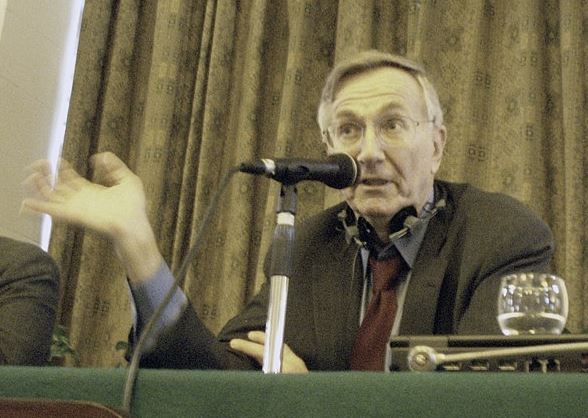 Seymour Hersch, 2007 | Photo by Hossam el-Hamalawy The New York Times called it a “mystery,” but the United States executed a covert sea operation that was kept secret—until now Two of the pipelines, which were known collectively as Nord Stream 1, had been providing Germany and much of Western Europe with cheap Russian natural gas for more than a decade. A second pair of pipelines, called Nord Stream 2, had been built but were not yet operational. Now, with Russian troops massing on the Ukrainian border and the bloodiest war in Europe since 1945 looming, President Joseph Biden saw the pipelines as a vehicle for Vladimir Putin to weaponize natural gas for his political and territorial ambitions. The motive: America’s political fears were real: Putin would now have an additional and much-needed major source of income, and Germany and the rest of Western Europe would become addicted to low-cost natural gas supplied by Russia—while diminishing European reliance on America. In fact, that’s exactly what happened. Many Germans saw Nord Stream 1 as part of the deliverance of former Chancellor Willy Brandt’s famed Ostpolitik theory, which would enable postwar Germany to rehabilitate itself and other European nations destroyed in World War II by, among other initiatives, utilizing cheap Russian gas to fuel a prosperous Western European market and trading economy. The direct route, which bypassed any need to transit Ukraine, had been a boon for the German economy, which enjoyed an abundance of cheap Russian natural gas—enough to run its factories and heat its homes while enabling German distributors to sell excess gas, at a profit, throughout Western Europe. Action that could be traced to the administration would violate US promises to minimize direct conflict with Russia. Secrecy was essential. Norway were the obvious collaborators: Back in Washington, planners knew they had to go to Norway. “They hated the Russians, and the Norwegian navy was full of superb sailors and divers who had generations of experience in highly profitable deep-sea oil and gas exploration,” the source said. They also could be trusted to keep the mission secret. (The Norwegians may have had other interests as well. The destruction of Nord Stream—if the Americans could pull it off—would allow Norway to sell vastly more of its own natural gas to Europe.) With a last minute change Joe Biden called for the charges not to go off with just a two-day timer, but to sit there ready underwater on the pipe and be triggered at some later date. This caused quite a stir and much frustration. It was a much more difficult requirement: The C4 attached to the pipelines would be triggered by a sonar buoy dropped by a plane on short notice, but the procedure involved the most advanced signal processing technology. Once in place, the delayed timing devices attached to any of the four pipelines could be accidentally triggered by the complex mix of ocean background noises throughout the heavily trafficked Baltic Sea—from near and distant ships, underwater drilling, seismic events, waves and even sea creatures. To avoid this, the sonar buoy, once in place, would emit a sequence of unique low frequency tonal sounds—much like those emitted by a flute or a piano—that would be recognized by the timing device and, after a pre-set hours of delay, trigger the explosives. (“You want a signal that is robust enough so that no other signal could accidentally send a pulse that detonated the explosives,” I was told by Dr. Theodore Postol, professor emeritus of science, technology and national security policy at MIT. Postol, who has served as the science adviser to the Pentagon’s Chief of Naval Operations, said the issue facing the group in Norway because of Biden’s delay was one of chance: “The longer the explosives are in the water the greater risk there would be of a random signal that would launch the bombs.”) On September 26, 2022, a Norwegian Navy P8 surveillance plane made a seemingly routine flight and dropped a sonar buoy. The signal spread underwater, initially to Nord Stream 2 and then on to Nord Stream 1. A few hours later, the high-powered C4 explosives were triggered and three of the four pipelines were put out of commission. Within a few minutes, pools of methane gas that remained in the shuttered pipelines could be seen spreading on the water’s surface and the world learned that something irreversible had taken place. How useless were the media? FALLOUT In the immediate aftermath of the pipeline bombing, the American media treated it like an unsolved mystery. Russia was repeatedly cited as a likely culprit, spurred on by calculated leaks from the White House—but without ever establishing a clear motive for such an act of self-sabotage, beyond simple retribution. A few months later, when it emerged that Russian authorities had been quietly getting estimates for the cost to repair the pipelines, the New York Times described the news as “complicating theories about who was behind” the attack. No major American newspaper dug into the earlier threats to the pipelines made by Biden and Undersecretary of State Nuland. Asked why he thought the Russians failed to respond, he said cynically, “Maybe they want the capability to do the same things the U.S. did. “It was a beautiful cover story,” he went on. “Behind it was a covert operation that placed experts in the field and equipment that operated on a covert signal. “The only flaw was the decision to do it.” Seymour Hersch also explains why he is writing for Substack and not the major outlets. “Here, I have the kind of freedom I’ve always fought for. “ See the videos below of all the US officials calling for action against the pipeline — looking for sanctions. Many interests in the US wanted to stop this pipeline.
UPDATED: Ian Rons disagrees, and is very unimpressed with the Hersch uncorroborated story. Worth reading it. Though it smelled like a weak effort with “legal” and political points at the top. (As if any government seems bound by law these days). But one point struck — he queries whether it was necessary to hide under the BALTOPS war games, as submarines could get in there anytime. And the delayed triggering by sonar drop does sound complicated. I also have deep reservations about the remotely-triggered detonators that were apparently designed and manufactured for this one operation on short notice, that survived over three months submerged under battery power in the cold Baltic Sea, vulnerable all the time to discovery, and which were apparently triggered by a single sonar buoy dropped from a Norwegian(!) aircraft, despite the fact that the explosions happened about 50 miles and precisely 17 hours apart. Every detail of that story raises a number of questions, but perhaps Sweden (which is carrying out the investigation) can tell us whether evidence of these sophisticated trigger devices has been found. Nonetheless, the debunking is not a heavyweight performance. Just points worth discussing. h/t Another Ian, Krishna Gans, Scott of the Pacific, Tony Thomas, Bill in AZ. Dr Peter Ridd compiled the statistics on coral reefs around the world, and even though China has installed a million megawatts of coal fired power in the last twenty years, there’s no evidence that corals are suffering significantly. Statistics on corals barely existed before 1980, and didn’t get semi reasonable until 1998 or so. But with twenty years of data there is no evidence suggesting we need to send in the SWAT teams with floating shade sails, giant fans, breeding teams, or sunscreen for staghorn coral. We do however need to send in the SWAT team to rescue our universities. 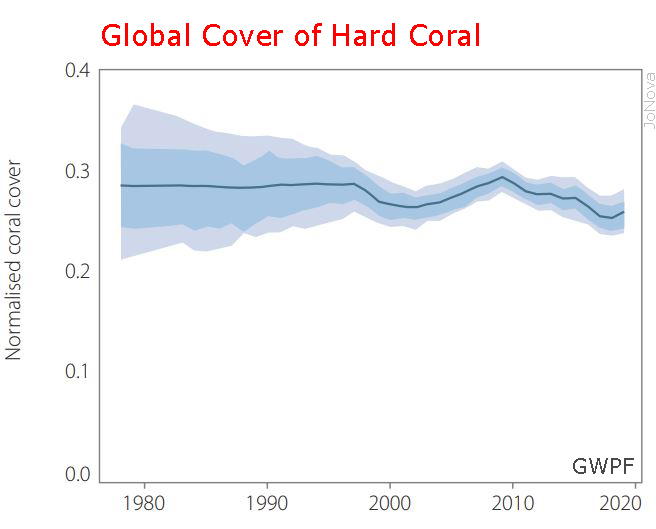 Hard Coral around the world is not suffering a mass die-off due to climate change, GWPF Bleached is not killedAcademic shaman have implied (tacitly) that bleached coral is like dead coral, but instead bleaching is more like home redecoration and the corals recover surprisingly fast. But amongst all this noise of loss and recovery, and with such short term data it’s been hard to see the big picture. The uncertainty bars on early coral studies expand like an emergency flare. But notice that there is no significant, distinctive response from corals despite CO2 being a well mixed gas spread all over the world. Where CO2 looks bad for some reefs one decade, it looks good the next. It’s almost like corals are being affected by something else entirely… 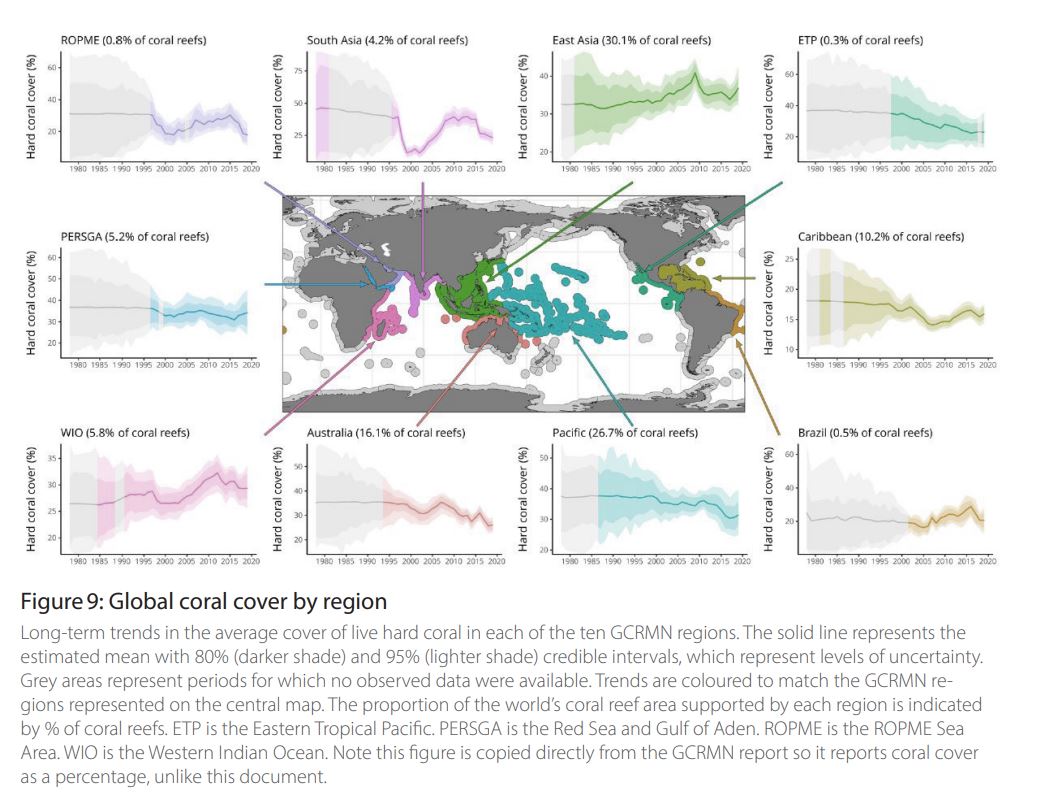 GWPF, Peter Ridd, 2023 (click to enlarge)
Peter Ridd takes a closer look at the four most important regions of corals, and the news for marine life is good. 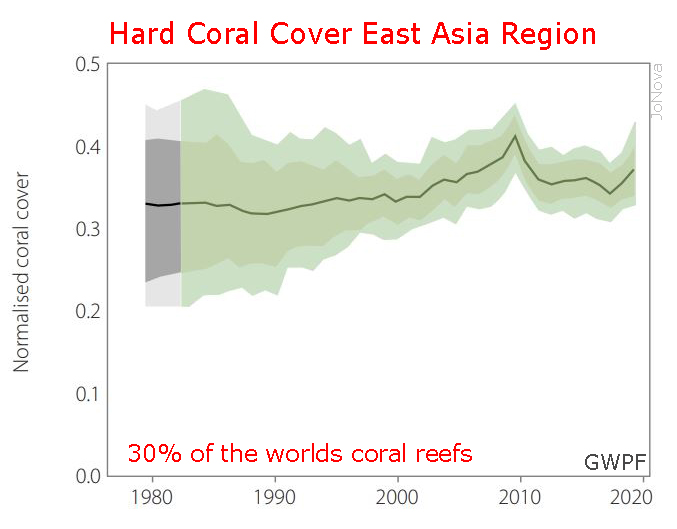 Hard Coral Cover of the East Asia Region, GWPF Why fear warming when corals love the hottest large water body on EarthThe area of most coral diversity, the ‘Coral Triangle’, in the seas around Indonesia, Papua New Guinea and the Philippines, is located at the centre of the Indo-Pacific Warm Pool – the hottest large water body on earth. This is not a coincidence. For every 1°C reduction in water temperature, there is a roughly 15% reduction in growth rate. Corals are also found in colder water, such as Scotland and Alaska, but their growth rate in these places is so slow that they are unable to form reefs.
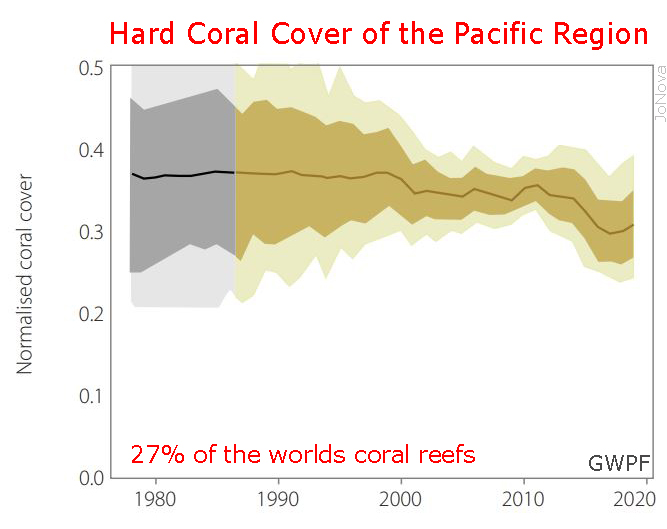 Hard Coral Cover of the Pacific Region, GWPF Because most of a reef is underwater, determining longterm changes in condition is difficult; historical archives of aerial photographs cannot be used.11 This is in contrast to monitoring the decline of the world’s tropical rainforests, where clearing of rainforests has been documented for about a century. The reduction in rainforest extent in Africa, Asia, and South America can be easily inferred from old maps and modern aerial photographs. Compared to rainforest loss, reefs are almost untouchedTo put this in perspective — we know we’ve lost half of the Australian rainforest yet all 3,000 reefs off Queensland are still there: For example, Google Earth images can be used to infer a 50% loss of Australian tropical rainforest, and almost total loss of lowland rainforest, since the European settlement, due to clearing for agriculture. Farms are now located where rainforest would once have been. However, for the GBR, all that can be said is that there has been no physical destruction of any reef on the scale of clearing for agriculture. All 3000 of GBR‘s reefs still exist, and all have coral on them. 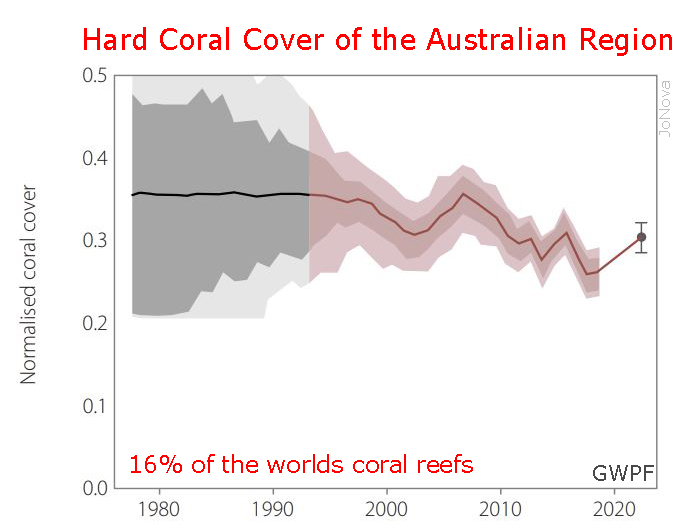 Hard Coral Cover of the Australian Region, GWPF Lord help us, it’s hard to get good dataData for Australian corals is probably the best in the world, but despite effectively surveying a strip of coral 1,000 kilometers long every year, the Great Barrier Reef is so large we are only sampling 0.003% of the total area. In order to appreciate the magnitude and difficulty of the task of monitoring reef systems, it is useful to consider the GBR, which has, by far, the most comprehensive monitoring program in the world. Carried out by the Australian Institute of Marine Science (AIMS), the ‘Long Term Monitoring Program’ (LTMP) only started in the mid-1980s – sporadic data exists for earlier periods, but is too limited for determining long-term trends. The GBR is huge – larger than Germany and as long as California – and has 3000 individual reefs, each a few kilometres across. AIMS surveys roughly 100 of the reefs each year using Manta tows, which means they cover roughly 1000 km each year. Despite this huge distance, the area surveyed represents only roughly 0.003% of the total area of the marine national park. In addition, AIMS covers around 100 small set transects with benthic surveys. The Caribbean reefs have survived three million years of climate changeThe coral cover in the Caribbean is lower than other regions, but hasn’t changed much in the last twenty years. The region has been separated from other coral regions for three million years — so has evolved on its own path. It’s hard to say if the lower coral cover is due to human or other damage that may have started long ago, or is just because these reefs have a different mix of species. In any case, it doesn’t correlate with CO2 either.  Hard Coral Cover of the Caribbean Region, GWPF Fast coral recovery is written off as “just the quick growing species”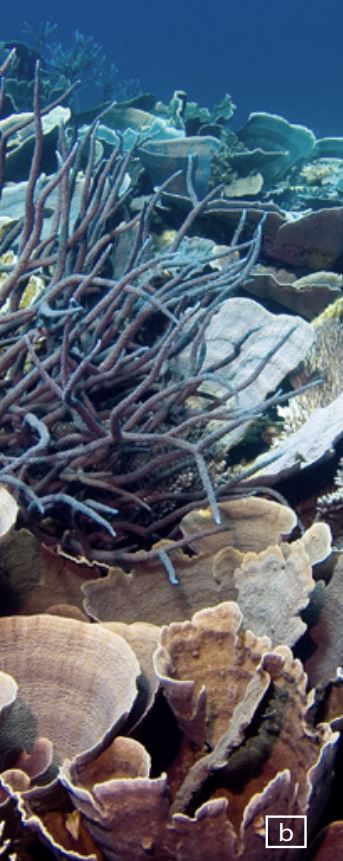 These are fast growing and delicate ‘plate’ and ‘staghorn’ corals that are When corals recover fast the academics and media imply that the new growth is somehow not as good or strong as what was lost. But as Peter Ridd points out they can’t have it both ways. These fast growing species are the same ones that got hit in the bleaching episodes in the first place. Slow growing corals are tougher and harder to bleach. So the new fast growing corals are just replacing the injured fast growing corals. Some corals like to live fast and die young These corals use bleaching as a strategy to adapt to different conditions. Some ‘high octane’ zooxanthellae will allow the coral to grow fast, but will make it more susceptible to bleaching from high temperatures. ‘Low octane’ zooxanthellae will make it grow slowly, but leave it less susceptible to bleaching.  An example of a ‘massive’ The life strategy of many corals, particularly the light and delicate ‘plate’ or ‘staghorn’ corals (Figure 1b), is to live fast and probably die young. They produce a lightweight calcium carbonate skeleton, which means that they will probably be obliterated by a tropical cyclone within 20 years. They are also highly prone to being eaten by crown-of-thorns starfish. As it happens, the return incidence for bleaching events and cyclones is often roughly the same and it is probably no coincidence that these physically delicate and easily damaged corals are the most susceptible to bleaching, and have a life expectancy of just a couple of decades. Taking on high octane zooxanthellae and growing quickly, while risking death by bleaching, is all part of their life strategy. At the opposite extreme are the massive corals that can live for centuries and become a solid block of calcium carbonate, metres across, and weighing tons. These grow more slowly, and will generally pass through a cyclone/hurricane relatively unharmed and are less affected by starfish plagues. They have a long-term strategy, and quick death by bleaching is not part of it. Bleached is not the same as dead coralThese reefs recovered so fast they could not have been killed in the first place. A coral that has been killed will need ten years to recover, but a bleached one is just redecorating with newer better zooxanthellae. While they [fast growing corals] can indeed regrow extremely rapidly (within a year) from a small section that is left alive (the so-called ‘phoenix effect’), if they are killed, recruitment of larvae and regrowth takes 5–10 years. They cannot regenerate within a few months. The rapid recovery of the reef cover therefore shows that they were bleached, but not killed. In other words, the past few years’ data has proven that very little coral was killed by the bleaching events – even the fast-growing coral that is most susceptible. Coral reefs can double or even quadruple their coral in a decade. The loss of a few percent from bleaching is a minor disturbance. Coral comes pre-adapted to climate changeFew other organisms have this type of adaptability to changing temperatures. Whereas many organisms take generations to alter their genetic make-up, corals can adapt to changing temperatures in a few weeks, simply by switching zooxanthellae during bleaching. Corals thus have a remarkable, almost unique, ability to deal with changing climates. Are they the ‘canary in the coal mine’, or one of the toughest organisms on earth, or somewhere in between? Academic tricks to make an 8% death rate seem like 93%The legendary 2016 bleaching was essentially word-game hyperbole: … it was widely reported that the 2016 bleaching event of the GBR affected 93% of reefs, with the implication that there was a 93% coral loss. However, if a reef had only a very small amount of bleaching, it was classified as one of the 93% of reefs that bleached… The best estimate for total coral loss on the GBR during the 2016 bleaching event is that, at most, about 8% died. Almost all of this was in very shallow water, less than 5 meters deep. Frade et al. (2018) showed that coral loss in water between 5 and 40 m depth was about 3%. Figure 4 demonstrates without doubt that the coral loss was small compared to the regeneration capacity of the reefs. Although there is no doubt that a significant amount of coral was killed by bleaching in 2016, it was far less than can be destroyed by a major cyclone, and far less than what was effectively reported by the media. This confirms previous work by De’ath et al. (2012) who found that cyclones and starfish plagues are responsible for 90% of coral mortality, and bleaching just 10%. The bottom line: The Reefs may or may not be fine, but science is in troubleAlthough it is extremely encouraging news, the latest statistics about coral reefs around the world, and especially recent ones from the GBR, do not prove that the world’s reefs are all going to be fine. However, they prove without any shadow of a doubt that the coral reef science community, with a few exceptions, is lacking in scientific integrity. They have cried wolf too often. REFERENCEPeter Ridd, (2023) Coral in a Warming World, Causes for Optimism, GWPF, February 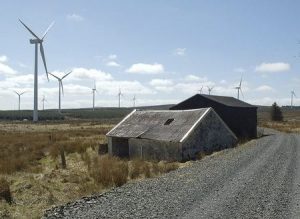 Arecleoch Wind Farm | Mary and Angus Hogg. While British people can’t afford to warm their own homes in winter some Scottish wind turbines are being rotated and de-iced with warmth from diesel generators which also leaked some 4,000L of diesel. Since this was due to a cabling fault, presumably the other shivering wind turbines are maintained with mains power? If giant turbine blades sit still too long, the bearings can generate permanent Brinelling damage. Alternately micro-oscillations or vibrations can cause False Brinelling. Small metal fragments then grind more of the metal around it, reduce efficiency, and increase the friction, the heat and the fire risk. It’s a couple of the hidden costs of maintaining a vast network of infrastructure to collect low density energy. Coal turbines must be slowly rotated too, to avoid the shaft bending, but coal turbines run for months at a stretch without stopping. One coal turbine can weigh up to 600 tons, but wind turbines nacelles usually weigh 100-300 tons, but can weigh up to 700 tons)*. The largest wind turbine blades can weigh 35 tons each. The power-to-maintenance ratio of wind turbines is absurd. The wind turbine industry today is like the jet engine industry of the 1950s. It will take decades of work to fine tune it and figure out true maintenance costs. The difference between jets and wind turbines is that in 1950 we knew we needed jets, but wind turbines are only useful in the fantasy land of junk climate models. If ever there was proof that wind power is a national security issue, a rort, and a risk… Dozens of Scottish Wind Turbines Powered by Diesel Generators, Pour Hydraulic Oil Into CountrysideJack Montgomery, Breitbart Scottish Power — led by a Spaniard, Ignacio Galan, and actually a subsidiary of Spanish firm Iberdrola — conceded that some 71 of its turbines had to be hooked up to diesel generators to keep them warm in December, according to the Sunday Mail, with a whistleblower telling the left-leaning newspaper that problems with the turbines are deep-seated. Keep reading → By Jo NovaRemember how the war with Ukraine was going to accelerate the green energy revolution? The Flakpanzer Gepard needs more ammo, not solar panels. Photo By Hans-Hermann Bühling For some reason, unreliable wind and solar power are not helping German industry build more tank ammunition. Instead, the federal government is allegedly talking to the state governments about taking green subsidies and spending the money on factories to build shells instead. And they are building those factories near the coal plants. Just a couple of weeks ago, the chief of Germany’s army warned that sending weapons and arms to Ukraine has left military stockpiles “bare”. Germany led the way in the great Green Energiewende transformation spending in the order of €32 billion a year, every year, in a quest for green electrons. Instead of creating peace on Earth and better weather, it just made the legendary economic powerhouse of Europe weak and vulnerable. Tell the world, if the Germans can’t run a nation efficiently on “renewable” power, who can? It’s perhaps not the Reset Klaus had in mind: Great Reset Fail? Germany Mulls Diverting Green Agenda Cash Aimed at Killing Coal to Arms IndustryKurt Zindulka, Breitbart
A report from Bloomberg claims that the federal government in Berlin is conducting confidential conversations with regional state governments to direct green subsidies to produce more weapons and ammunition and thereby create more jobs in areas of the country impacted by the attempted move away from coal. According to a source familiar with the plans who spoke to the news organisation, German defence contractor Rheinmetall AG is planning to build a factory to produce the basic components for ammunition in the state of Saxony, one of the main hubs of the coal industry in the country. Trump did warn them. Now the German Greens despair, –Ruairi Two days in a row, this blog has been quoted in the Daily Telegraph. Congratulations to Clarissa Bye for shining a torch on the BoM Craig Kelly found the wandering solar panel leaning on a bush near Sydney’s official thermometer, and I wrote about what a strange spot that was to leave a solar panel. Then Clarissa Bye of the Daily Telegraph picked up the story and on Jan 25th asked the BoM why the panel was there. After a whole week of missed deadlines, with pleas for extra time, The Daily Telegraph gave up waiting and published the story Wednesday: Questions raised over mystery solar panel at Sydney ObservatoryScience blogger Jo Nova has also queried the solar panel’s location, describing the BOM as “lackadaisical” at best in maintaining weather sites. “The solar panel is exactly due south of the Stevenson screen where the thermometer is kept,” she said. “If, hypothetically, someone wanted to leave a reflective object pointed at the box at midday, that’d be the place to do it.” ““There’s only been one day above 30 degrees since February 21st last year in Sydney, and that was a day when the wandering solar panel was visiting the thermometer, seemingly connected to nothing and leaning on a bush.” Meanwhile the BoM, which didn’t have time to answer questions, somehow found time to take the embarrassing panel away. Then finally, the BoM responded to Ms Bye and my thoughts are “wow… it took them a whole week to come up with that?” Apparently the strange panel has been there for almost a whole year now, and was being used as backup power for the weather station, just in case there were blackouts due to renovations at the school next door, and if you believe that… BOM responds to vanishing solar panel mysteryClarissa Bye, The Daily Telegraph, Feb 2, 2023 The solar panel mysteriously vanished after media questions were asked, but the Bureau of Meteorology has now issued a statement saying the panel was erected because of potential power interruptions due to a nearby construction of a school. It stated the panel was installed in February 2022 and removed in January 2023 “as it was no longer required to supply power to the weather station once the mains power was restored in December 2022”. “The solar panel could not be placed on a roof due to heritage restrictions, so was placed at an appropriate distance on the grass nearby,” the BOM stated. As Jo Nova said — there is nothing “appropriate” about this distance, and the BOM knows it.  That’s a strange spot to leave a panel… | Craig Kelly Clarissa Bye sent me the BoM reply and most of my responses were put into the online Daily Telegraph update yesterday: Asked if the BOM was confident that the reflected heat would not affect recordings on the temperature gauge, the BOM spokeswoman stated: “Any potential impact from the installation and removal of the solar panel will be assessed as part of routine quality assurance processes used by the Bureau for all weather station data. Climate and science blogger Joanne Nova said that the solar panel should have been located elsewhere on the site and placed so that the reflection was never on the Stevenson screen. “The BOM is not confident it has no effect or they would have said so,” she said. And as I added: “An even better answer would have been ‘we bought a 30m extension cord and put the panel far away’. Which obviously the BoM didn’t do. And that raises other questions: “If this panel was a back up for the Stevenson equipment then where was the battery? A solar panel on its own is no use as a mains replacement if the power fails at night.” Mowing the grass around that panel for a whole year must have been a pain too, right? I really have a problem with the lack of any care for site conditions and raw data. Does climate science matter? “They evidently did not make even the slightest effort to put the panel in there in such a way to minimize the impact. “Indeed, it‘s hard to think how they could have put it in a more suspicious place than they did. As usual, the BOM don’t care less about recording accurate temperatures. They’d rather play statistical games after the fact to try to fix the errors. Does their “routine quality assurance”, mentioned above, involve homogenization with “neighboring sites” a thousand kilometers away? Perhaps the site in Cobar will detect the effects of the solar panel in the backyard of the observatory? Does that sound like expert science? The most important thing here is that there are many better locations within the small enclosure for that solar panel, even if a first world country needed a makeshift panel in the centre of their largest city “for reliable supply” — which is another crisis all of its own. The panel could have been placed to get the morning sun at the Western edge of the patio (at least). It could have been placed to make sure the reflection was never on the Stevenson screen. UPDATE: The solar panel was left where the red line is, directly south of Stevenson screen (the white box) — the ideal place to reflect the midday sun (if that was the aim). There are many other places they could have picked especially with an extension cord. A better answer from the BoM would have been: ” We needed the panel for back up supply from day x until day z. This temporary addition was recorded in the metadata. The angle was calibrated at xx% to make sure it collected sun but at no time reflected directly onto the Stevenson screen.” None of that happened. Craig Kelly has put in an FOI to get more answers. And Jennifer Marohasy wants answers in court:Institute of Public Affairs senior fellow Dr Jennifer Marohasy – who is in a court battle with the BOM to access historical weather records – said the solar panel fracas “undermined” the bureau in the absence of other explanations. The BOM has accidentally admitted the solar panel was definitely there when the site recorded 30.2°C on January 18th. Indeed it may have been warming temperatures the entire time since the last time Sydney reached more than 30°C on Feb 21 last year. The whole time Sydney has been “below 30°C” there was a strange solar panel pointed at the official thermometer. What’s next: Time for Tanya Plibersek to explain BoM scienceTanya Plibersek is the Minister for Environment and Water and is responsible for the BoM. If scientific standards there are so low, and if climate science matters, what is she doing to fix it? Billions of dollars of policy rest on solving an alleged problem with the Australian climate, yet the BoM can’t even be bothered to set up quality weather stations or maintain them properly? |
||||
|
Copyright © 2024 JoNova - All Rights Reserved |
||||

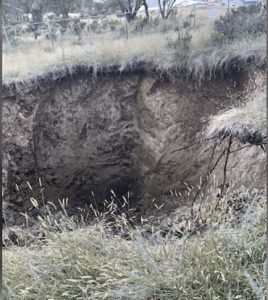
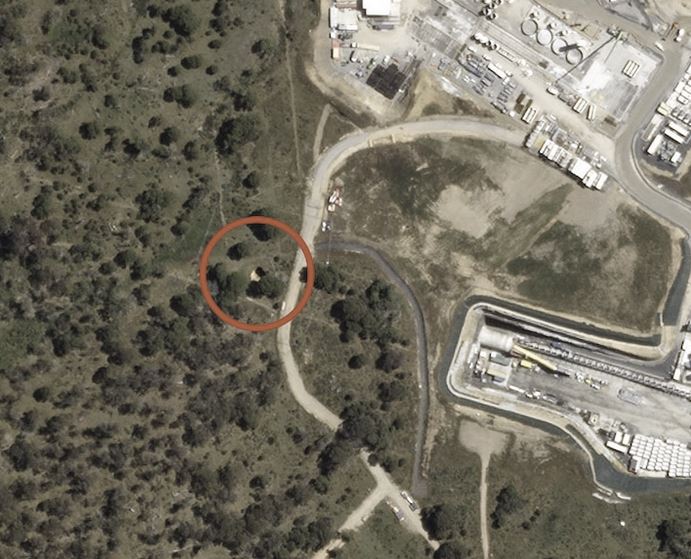


 The German government is reportedly considering diverting green agenda subsidies aimed at cutting coal power to the defence industry in order to ramp up production of arms amid the war in Ukraine.
The German government is reportedly considering diverting green agenda subsidies aimed at cutting coal power to the defence industry in order to ramp up production of arms amid the war in Ukraine.

 Tony Thomas at
Tony Thomas at 
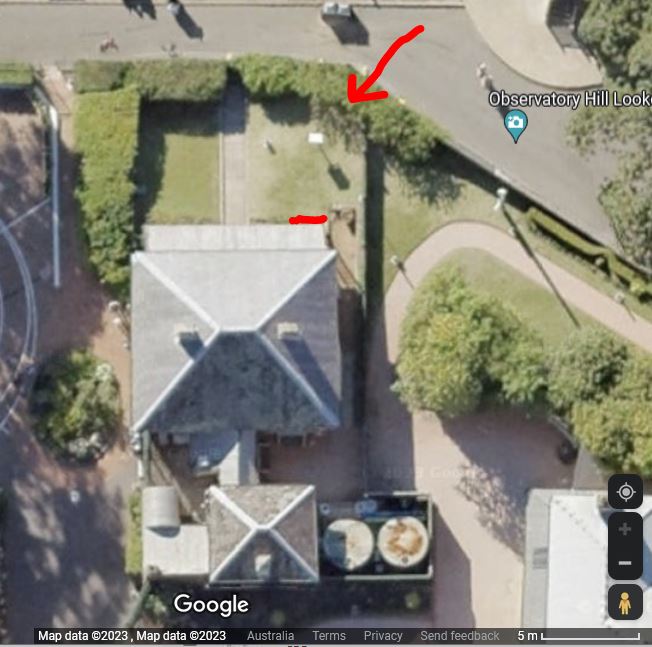











Recent Comments